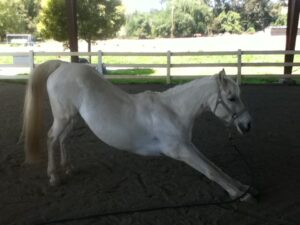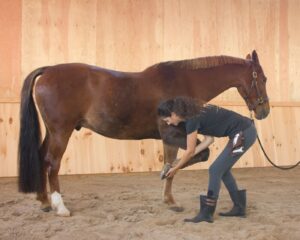Get hands-on to help your horse re-calibrate his or her resting posture and relaxation levels. Equine Hanna Somatics® (EHS) is a proven method of movement-education that targets the part of a horse’s brain that controls the muscles of movement.
EHS is gentle enough for every horse at any age or stage of athletic development. EHS is fantastic for enhancing performance and increasing endurance. EHS can be very complimentary to the healing and rehabilitation process – once your vet has decided that the horse is ready to begin gentle work post injury or illness (ie. been cleared for ‘hand-walking’).
Unlike most forms of equine bodywork, when we do Equine Hanna Somatics, we are working WITH the horse by asking the horse to voluntarily pandiculate various groups of muscles.
This is what makes EHS so unique in the field of Bodywork or Mind-Body Integration, and also what makes it SO extremely effective!
What is Pandiculation?

Pandiculation is a polysynaptic reflex that involves contracting a muscle or group of muscles, and then slowly reducing the contractions back to neutral.
You have seen a cat or dog pandiculate after waking from a nap – it looks like a big crazy stretch, often accompanied by a yawn.
Thomas Hanna discovered that by intentionally performing this kind of movement, doing a voluntary pandiculation, we cause the brain to do it’s own diagnostic on the muscles involved and reset the resting level of those muscles back to neutral. (goodbye tension!)
Meet the creator of EHS – Eleanor Criswell Hanna
The Principles of Equine Hanna Somatics
- The horse must do the work!
- Invite the movement without using force or providing much resistance, only a gentle hands-on feel for direction.
- The horse chooses how far to move – do not ask the horse to move beyond his or her current easy range of motion. In EHS, smaller is often better!
- The SLOW RETURN TO NEUTRAL is the MOST IMPORTANT PART!
- Do your best to avoid stretching or pulling on the horse, and do not use treats.
Limb movements in healthy horses are preceded by flexing the poll and spine, thus lifting the back and shifting weight to the hind or forequarters and to the opposite limb – so give the horse plenty of time to respond to your invitation.
According to Eleanor Criswell Hanna, the creator of Equine Hanna Somatics (and co-creator of Hanna Somatics), a horse in an unhealthy state (one that is stiff, fearful, or in pain) may resist pickup, or struggle to shift weight to the other three legs.
Do NOT force the horse to do a pick-up. If you force EHS, you will not get the beneficial results!
Remember – The goal is to get the horse to participate mindfully in the movements – not to change the posture or position of the body. The changes in posture will come later, either as the horse integrates the release of tension from this session, or in subsequent sessions as the horse is able to release more and more of the accumulated Sensory Motor Amnesia.
How to Do the Initial Pick-Ups of EHS

Begin with the left front leg, and invite the horse to lift his or her hoof. Keep your hands connected to the limb as you invite the horse to slowly lower the hoof back to the ground and stand on it.
Repeat each pick-up and slow put-down three times in a row before moving on to the next leg, inviting a total of 3 pick-ups with each of the horses four legs.
Avoid using any conditioned cues (like pinching, pulling, squeezing or finger snapping) and instead invite the horse to pick up his or her own hoof using your position, a gentle feel, and minimal steady pressure.
Remember that the SLOW coming back down is the most important part of each pick-up.
Each time the hoof comes to the ground, if the horse doesn’t automatically put weight back on the leg, ask him/her to shift the weight over and stand on that leg – this is to avoid leaving a bit of tension in Deep Digital Flexor muscle and tendon.
Do not force the horse – if the horse is refusing or cannot cooperate for some reason, simply move on to the next leg, and try again tomorrow!
If your horse is suffering from laminitis or founder, I teach a modification to this movement that will help them even more right here.
Want to LEARN MORE?
If you are ready to get hands-on and really help your horse relax and unwind, click here to Get My Top 3 EHS Exercises for Any Horse – Free!


